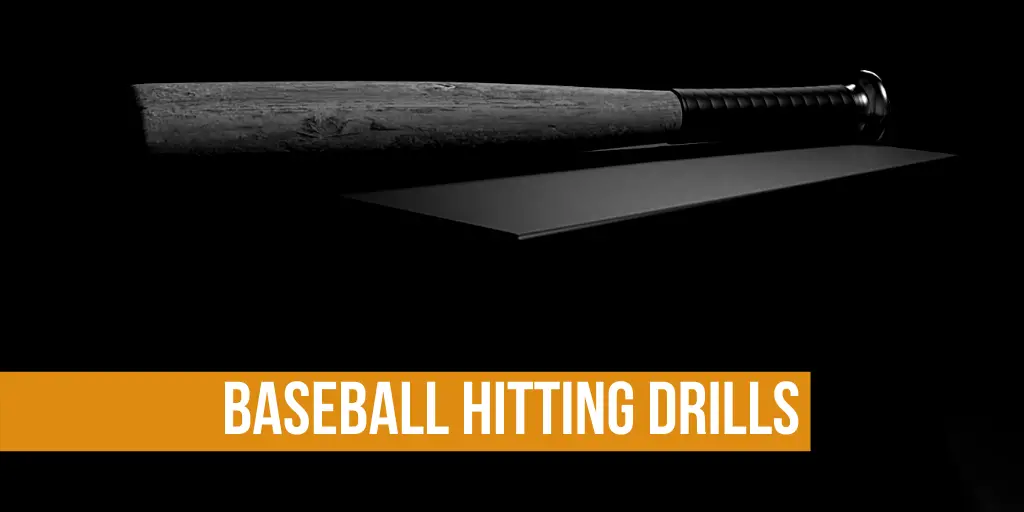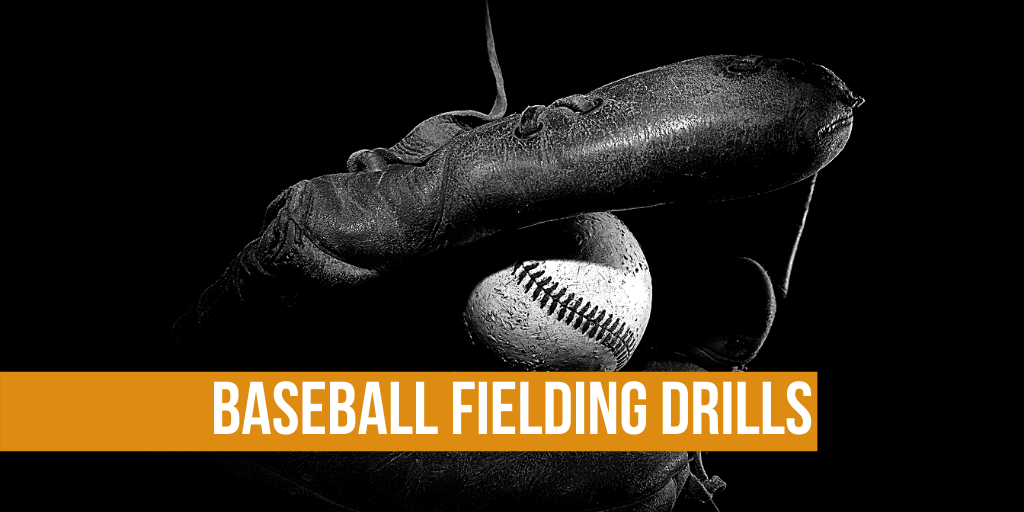Baseball Conditioning Drills

Baseball Conditioning Drills
Whether it’s so you can hit the ball with more power, improve your base running skills or increase the velocity of your throws – one things absolutely in certain at some point you’re going to have to look at your conditioning.
While long distace running can be beneficial you’ll be happy (or not!) to know the workouts, exercises and conditioning drills below are suited for baseball players NOT marathon runners. Here’s what we mean…
Sports conditioning is a vital component of any athletes career.
But, depending on the sport they type of conditioning you’ll do changes.
Baseball is a power and explosive sport. So, for that reason your conditioning drills should reflect this. Afterall you wouldn’t send in a 200 lbs bodyweight builder to compete in the Olympic high jump!
Planning Your Conditioning Routines
So, as baseball is an explosive sport with lots of short burst of speed (acceleration of some sort then rest periods) it makes sense that our baseball conditioning drills should mimic these same scenario.
In the workouts, exercises and conditioning routines below we have brought in a wealth of knowledge in the sports conditoning area to layout the best baseball specific conditioning drills you can use to improve your all round performance.
Now, it’s also worth concidering that while most players will perform the same conditioning drills some positions on the field will require extra special attention for you too not only deliver baseball specific conditioning drills but player position conditioning drills too.
Finally, incorperate different training aids and equipment into these workouts and exercises in real-game scenarios within training. There’s nothing stopping you from adding a power explosive movement straight after a player has just hit a sweet one right off the batting tee.
After all, their level of explosiveness will determine how quickly they can get to the next base.
Similarily, using pitchbacks, hitting nets, weighted training balls, pitching targets and even fungo bats as part of your conditioning drills will ensure you keep your conditioning workouts super-specific.
With that said, here’s are best conditioning baseball drills for your next training session…
Baseball Strength & Conditioning Drills
Strength training will not only allow you to throw better and hit harder but adding strength conditioning exercises to your workouts can also reduce the risk of injury too.
We’ll start off with some bodyweight exercises coupled with additional equipment such as; bands, and medicine balls.
These types of conditioning drills are esspecially useful for youth baseball players but can (and should be) used by all ages with a little bit of adapting.
Bodyweight
![Baseball Conditioning Drills: Exercise diagram of someone doing a Plyo Push Ups [MindfuseBaseball.com]](https://mindfusebaseball.com/wp-content/uploads/2020/06/Plyo-Push-Ups.png)
![Baseball Conditioning Drills: Exercise diagram of someone doing single leg RDL's and Power Push Aways [MindfuseBaseball.com]](https://mindfusebaseball.com/wp-content/uploads/2020/06/RDLs-and-Power-Push-Aways.png)
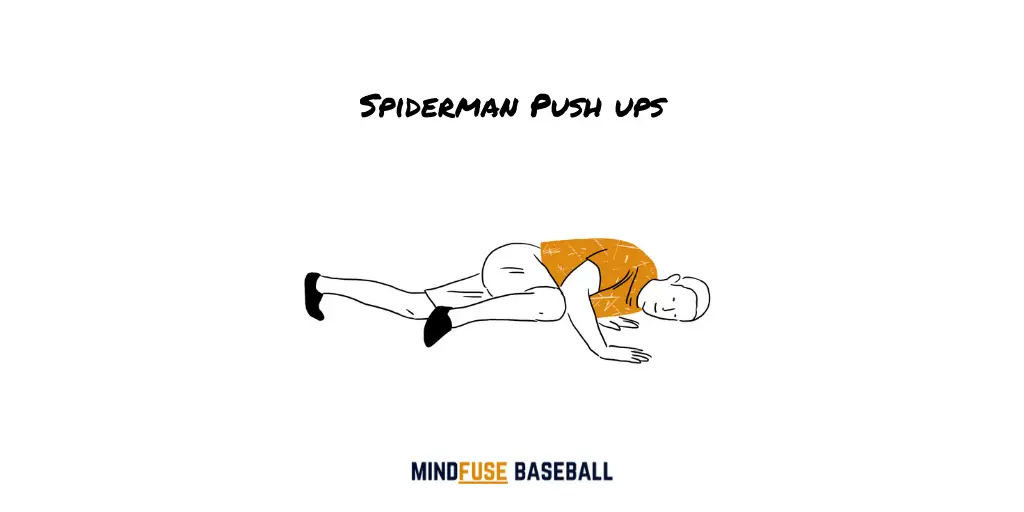
Plyo Push Ups: Like normal push up but on the upward phase of the movement you’ll explosively lift both hands off the ground
Single Leg RDL’s: Great exercise to build stability and strength. Start by balancing on one leg with the band securly under the other foot. Lean foward at the waist until about 90 degrees then return to the start position pulling the band and engaging your hamstrings and glutes.
Shoulder Pushaways: Assume the ‘bent’ knee push up position without letting your knees touch the ground. Instead of going straight down as you would with a push up you’re going to move your chest towards the tips of your fingers to engage the shoulder. Then push back in the same way you would if doing the barbell shoulder press.
Spiderman Push Ups: This is push variation than can be taken up a notch or two. On the downward phase, bring your right knee up to touch your right elbow. Then return to starting position and repeat for the opposite side.
Programing: Do these exercises in sets of 3 and go to failure on each set.
Medicine Ball
![Baseball Conditioning Drills: Exercise diagram of someone doing rotational medicine ball throws [MindfuseBaseball.com]](https://mindfusebaseball.com/wp-content/uploads/2020/06/Rotational-Medicine-Ball-Throws.png)
![Baseball Conditioning Drills: Exercise diagram of someone doing Overhead medicine ball throws [MindfuseBaseball.com]](https://mindfusebaseball.com/wp-content/uploads/2020/06/Overhead-Medicine-Ball-Slams-Over-Head-Squat-Throws.png)
Rotational Medicine Ball Throws: Stand side on to a wall with medicine ball in hand and your feet shoulder width apart. Twist at the torso and throw the ball at the wall making sure to catch the ball on the rebound.
Overhead Slams: Stand with your knees shoulder width apart with the medicine ball held above your head. Then slam the ball as hard as you can down towards the ground.
Overhead Squat Throws: With the medicine ball in both hands. Squat down and explosively come back up. On the upward phase release the ball by throwing it as high as you can. This can be done next to a wall or by simply throwing the ball as far as you can behind you.
Baseball Agility Drills With Cones
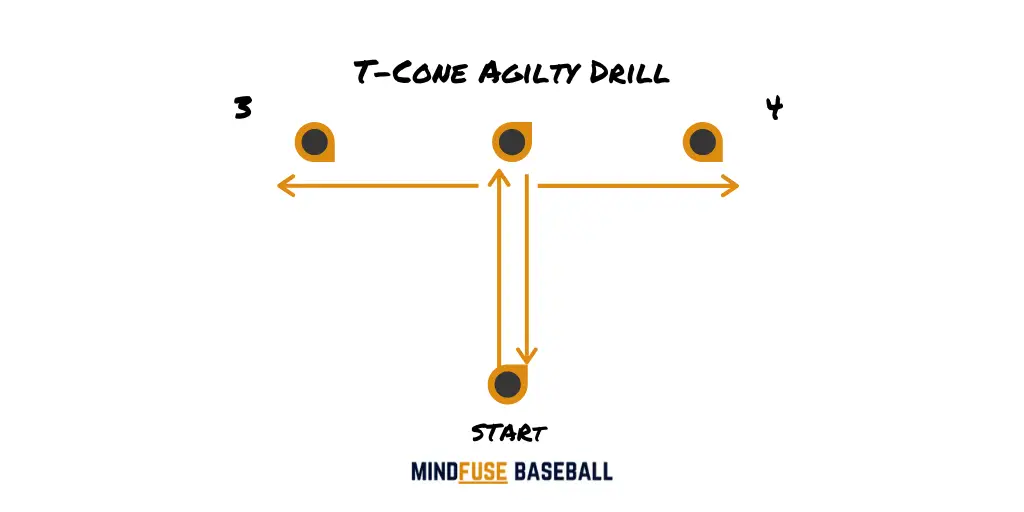
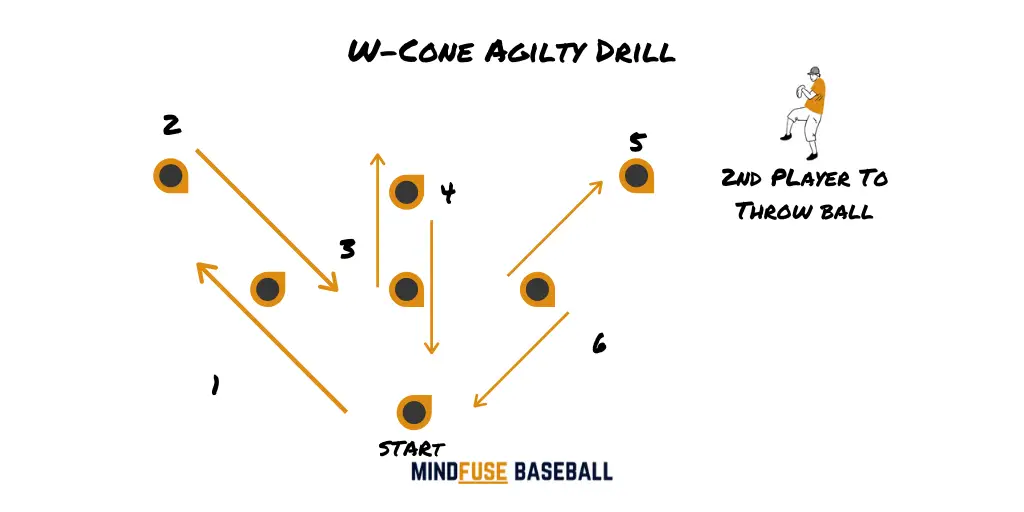
T-Cone: Setup between 4-8 (depending on the amount of ‘stations’ you want) cones in the shape of a ‘T’. Start at cone ‘1’ (see image) sprint to the 2nd cone and then back to the 1st. Then you’ll sprint back to the 2nd cone, change direction and sprint to cone 3. Then return back to the starts and repeat for cone 4.
To increase reaction time you can add a second person that calls out the color of the cone or points to the cone that you must run to next.
W-Cone: Similar idea but this time you’ll sprint in a shape of a ‘W’. Have a second player positioned outside the drill to throw a baseball to be caught once the player reaches the last cone.
Remember the player can use all sorts of movements to complete the circuit in from straight out sprints, to side steps, jumps etc. Try mimic fielding position movements as much as possible.
Sled Pushes
Why This Drill? Power sleds are fantastic pieces of equipment to build strength in the legs. Now not everyone has access to a sled in their home or at the training ground so you can also use an old tire.
Details: Essentially this drill focus on pushing the sled (or tire) for a period of time.
Progressions & Regressions: Pushing a sled or a tire can be progressed by using different surfaces to push the sled on (friction) or by loading the sled or tire up with additional weight. You can also add the sled pushes into a circuit of strength and conditioning exercises.
Progressive Sprints
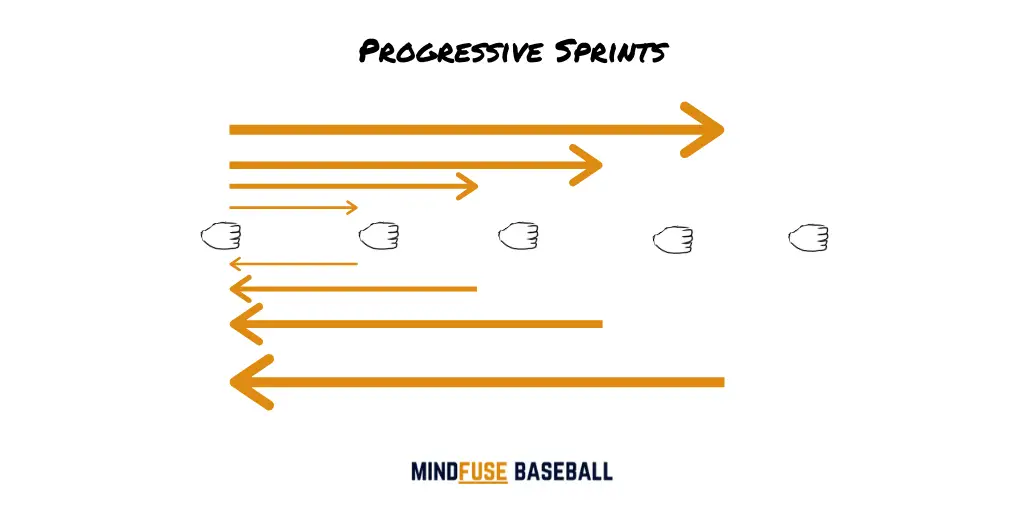
Why This Drill? Baseball is a game of short burst of action. That’s why it’s important to not only limit the amount of long distance your players do but to replace it with progressive sprints.
Details: Setup 5 gloves at different distances apart. The player must sprint to the first and then make their way back to the beginning. Then sprint to the second and back to the beginning. Then to the 3rd, 4th and 5th using their return to ‘home base’ as their recovery period.
Progressions & Regressions: You can start with 3 gloves – rest – then progress to 4 and finally to 5 gloves.
Kettlebell Swings
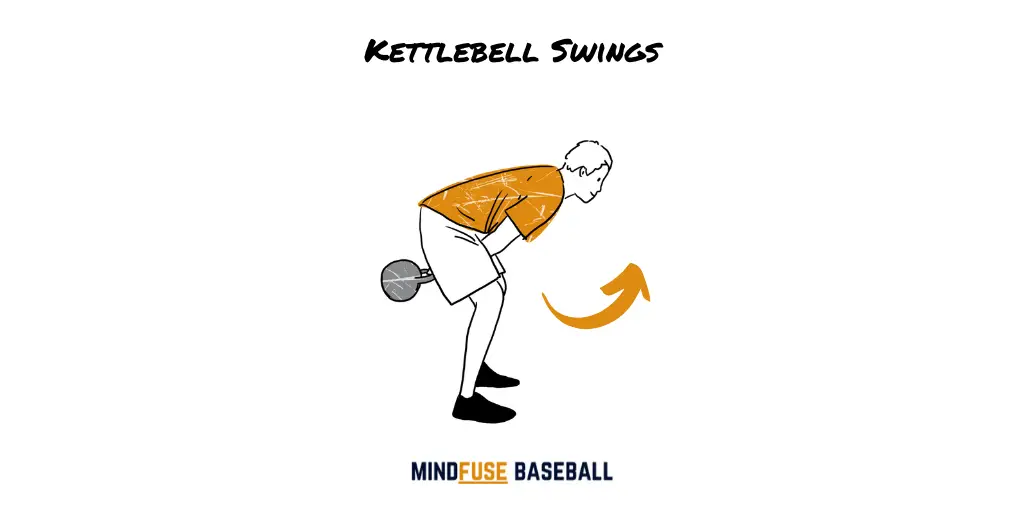
Why This exercise? Kettlebells are great pieces of equipment that you can keep at home taking up minimal space. Kettlebell swings are brillaint exercises for baseball players as they condition the core, glutes, hips, hamstring and shoulders – essentially a full body movement.
Details: Get your feet slightly further than shoulder width apart and hold the kettlebell with both hands between your legs. Back straight and knees bent. Drive your torse forward and straighten your legs so that the kettle bell is pushed forward and upwards. Ensure you keep your back straight throughout and NOT use your arms to swing the kettlebell. The whole movement should be driven from your legs and your hips.
Progressions & Regressions: Again, you can add other conditioning exercises to this exercise in cisrcuit fashion.
Battle Ropes
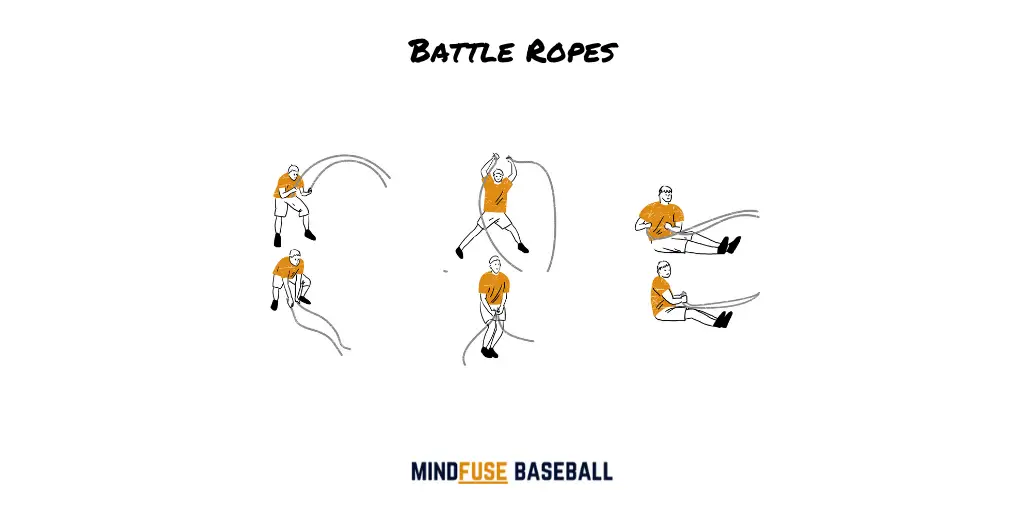
Why This Drill? Battle ropes allow you to exert a lot of force while having the risk of injury reduced to almost nothing. Battle ropes can also help increase range of motion.
Details: There are hundreds of ways you can use a battle ropes. A few to start with are; Power Slams, Alternate Waves and Side to Side Waves.
Progressions & Regressions: You can change the timing of the workout, the battle rope exercises themselves and the other exercises you add in.
Conditioning Circuit
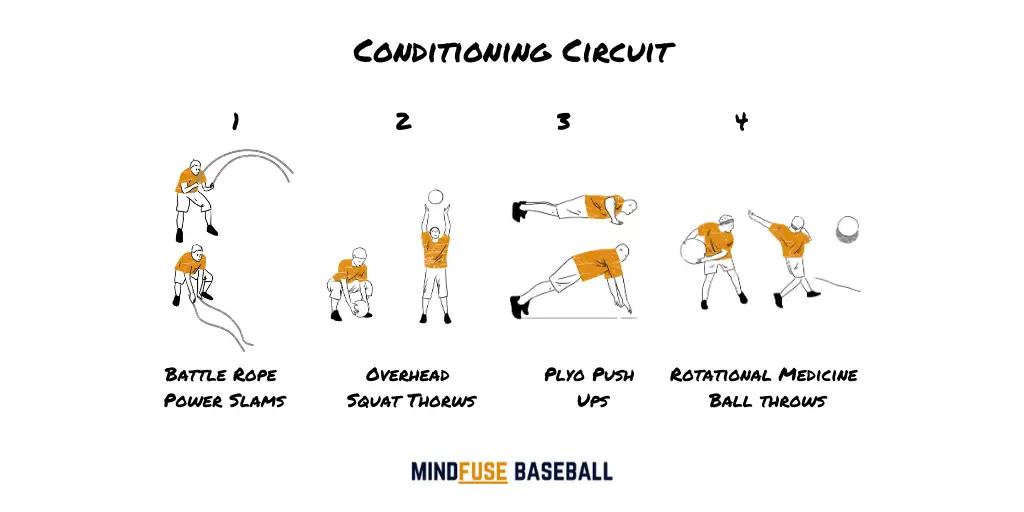
Why This Drill? Conditioning circuits are great for both individuals and large groups. You can also have as many or as little stations as you want.
Details: For this example, pick 4 exercises to be performed at each station. Perform each exercise for 1 minute per station for total of 4 minutes. Then rest 90 seconds and repeat 2 more times for 3 rounds.
Progressions & Regressions: Go for 5 rounds.
Footwork Ladder Drills
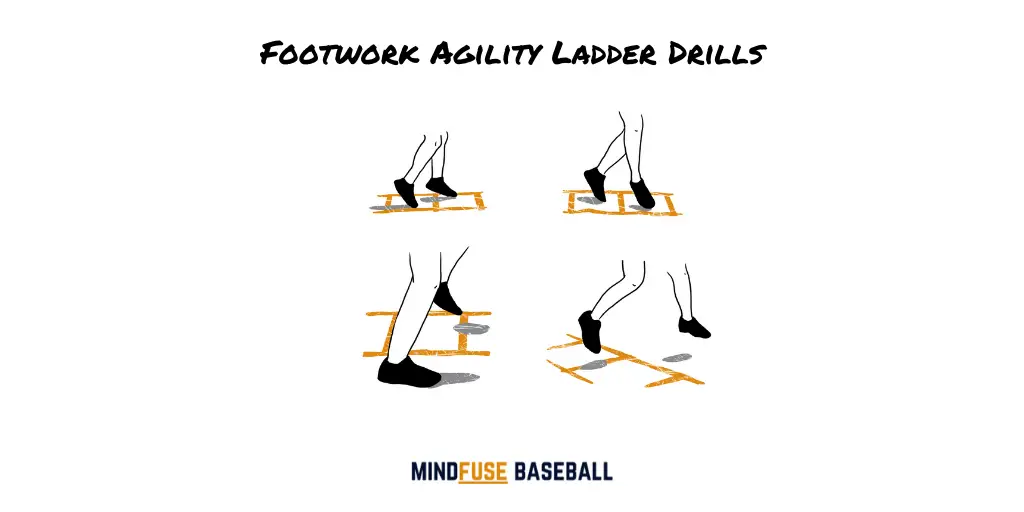
Why This Drill? Ladders improve 3 areas of your baseball game; speed, agility and quickness. They can also be picked up pretty cheap on amazon.
Details: Like battle ropes, Ladder Drills have hundreds of variations. Check out the video opposite for some ideas on how to use your ladder in your next conditioning workout.
Progressions & Regressions: Ladder drills can also be used in conjuction with battle ropes and other conditioning exercises. They’re also a great station to have in your conditioning circuits.
Baseball HIIT Workouts
HIIT or High Intensity Interval Training is also a great way to conditioning your body. It essentially consists of alternating work periods with strategic rest periods.
You can pretty much use most exercises for a HIIT workout as long as you set strict ‘ON’ and ‘Recovery’ periods. There are a number of different ways to structure your HIIT workout depedning on the protocol you want to use. Here are few to get you started:
- Tabata: 20 seconds of exercise followed by 10 seconds of rest. How many of these you do is entirely up to you. And, whether you do the same exercises or mix and match is again up to you. I would recommend you aim for 2-4 exercises to rotate between in your workout. With a balance between lower and upper body exercises.
- Wingate: This protocol focuses on ALL OUT PHYSICAL EXERTION for 30 seconds. Followed by 4 minutes rest then repeated 4-6 times.
- Gibala: Martin Gabala’s protocol consist of a workout called ‘The Little Method’. It involves doing a 3 minute warm up. Then into a 60 intense period of exercise with 75 second rest. Then this is repeated over 8-12 times.
Indoor Conditioning Drills
Many of the drills and exercises I went into detail on above can (and should) be done indoors.
That said however, if you’re looking to adapt your conditioning drills for indoors (depending on the space you have available) you can use a combination of:
- Cone drills
- Strength exercises
- Portable conditioning equipment (Kettlebells, bands and battle ropes)
- Bodyweight exercises
Agility Drills
Having good agility is the ability to change direction at speed.
So with that said using a combination of sprint intervals and the t-cone and w-cone drills from above will help you and your players develop a level of agility needed to excell in their game.
Ladders are by design another great tool to use for agility development.
